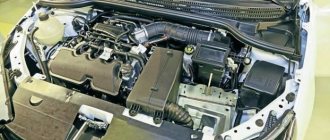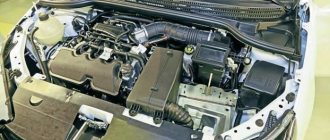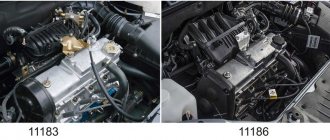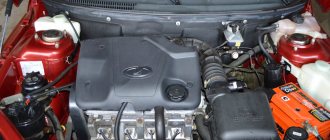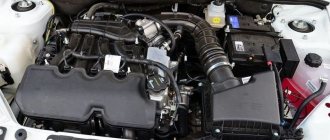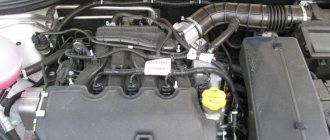Lada Granta engines 8 valves
This power unit was installed only until December 2014, until it gave way to the 11186 internal combustion engine. This is an injection 8-valve engine with a single camshaft, a timing belt drive and without hydraulic compensators, so the thermal valve clearances here will have to be adjusted yourself. Thanks to special holes in the pistons, if the valve belt breaks, it will never bend.
There are plenty of problems with this engine; first of all, owners are bothered by all sorts of noises, knocks, and vibrations. Unreliable electrics, as well as a capricious thermostat, can throw you many unpleasant surprises. Due to poor fuel, valve burnout sometimes occurs here.
Sedan before restyling 2011 - 2019
| 1.6 l 11183 MKP5 | |
| Type | injector |
| Fuel | gasoline AI-92 |
| Location | transverse |
| Cylinders | 4 in a row |
| valves | 8 |
| Working volume | 1596 cm³ |
| Power | 82 hp |
| Torque | 132 Nm |
| Acceleration to 100 km/h | 12.6 s |
| Speed (max) | 165 km/h |
| Ecological Class | Euro 4 |
| Consumption city | 9.7 l |
| Flow track | 6.1 l |
| Mixed flow | 7.4 l |
Similarly, the Motor VAZ website talks about all the details of the internal combustion engine design
This unit is an improved version of the previous one. There is already a lightweight piston with anti-friction inserts, a timing belt from Gates with a service life of 180 thousand km, an electronic throttle valve, a developed cooling jacket and many other improvements, thanks to which it was possible to fit this rather old engine into the strict EURO 4 econorms. Due to the new pistons without holes in the bottom, if the valve belt breaks, it almost always bends. Update: in mid-2022, the manufacturer equipped the unit with plugless pistons.
The list of typical malfunctions of this power unit is quite long. Owners of cars with such an engine regularly encounter burnout of valves due to bad gasoline, overheating, oil leaks, failures of various sensors, and also glitches of the E-gas system.
Sedan before restyling 2011 - 2019
| 1.6 l 11186 manual gearbox5 | 1.6 l 11186 automatic transmission4 | |
| Type | injector | injector |
| Fuel | gasoline AI-92 | gasoline AI-92 |
| Location | transverse | transverse |
| Cylinders | 4 in a row | 4 in a row |
| valves | 8 | 8 |
| Working volume | 1596 cm³ | 1596 cm³ |
| Power | 87 hp | 87 hp |
| Torque | 140 Nm | 140 Nm |
| Acceleration to 100 km/h | 12.2 s | 14.2 s |
| Speed (max) | 167 km/h | 160 km/h |
| Ecological Class | Euro 4 | Euro 4 |
| Consumption city | 9.0 l | 10.4 l |
| Flow track | 5.8 l | 6.1 l |
| Mixed flow | 6.6 l | 7.7 l |
The technical features of the engine are described in an article in Za Rulem magazine
What changed?
By “lucky coincidence,” the author was the owner of a Granta (a 2017 liftback, in the minimum Norma configuration) and came to the test armed for comparisons.
In 2022, VAZ carried out a restyling, designing the front in the “X-style”. The main pair in the transmission was changed from 3.7 to 3.9. All engines were made “non-plug-in” - if the timing belt breaks, the pistons do not meet the valves. Engine control program calibrations have been adjusted. For example, the eight-valve engine now picks up more confidently after the first outbreaks during a cold start. The temperature regime has also changed. If during the cold season you see that the operating temperature after warming up has frozen around 80–82 degrees, do not be alarmed. The thermostat in this case is working properly.
The new dashboard is beautiful and easy to use. But it’s much more “talkative” than the simple old one - with a minimum number of parts, caps and designer inserts.
The new dashboard is beautiful and easy to use. But it’s much more “talkative” than the simple old one - with a minimum number of parts, caps and designer inserts.
The 1.6 (98 hp), 4AT Luxe (from RUB 660,800) package includes an audio system and four speakers. |
In version 1.6 (87 hp), 5MT Classic (from RUB 506,500) there is only audio preparation. You will have to purchase and install the radio at your own expense. |
If you take a car without a radio, only with audio preparation, keep in mind that the speaker wiring to the doors is laid normally, and the antenna cable is a pure formality. It runs from the roof antenna to the bottom of the right A-pillar trim. Without an extension cable, you won't be able to reach the audio center.
Lada Granta engines 16 valves
This engine is also equipped with a lightweight piston group manufactured by Federal Mogul and a belt with an automatic tensioner from Gates. It is distinguished by a 16-valve head with a pair of camshafts and hydraulic compensators, due to which its power is significantly higher.
All the problems of its predecessors apply to this unit in full. The engine often suffers from lubricant leaks, tripping, floating speed, sensor glitches and valve burnout. Plus, you can add hydraulic compensators that are very demanding on oil quality.
Hatchback before restyling 2015 - 2019
| 1.6 l 21126 MKP5 | 1.6 l 21126 automatic transmission4 | |
| Type | injector | injector |
| Fuel | gasoline AI-92 | gasoline AI-92 |
| Location | transverse | transverse |
| Cylinders | 4 in a row | 4 in a row |
| valves | 16 | 16 |
| Working volume | 1596 cm³ | 1596 cm³ |
| Power | 98 hp | 98 hp |
| Torque | 145 Nm | 145 Nm |
| Acceleration to 100 km/h | 11.2 s | 13.3 s |
| Speed (max) | 182 km/h | 173 km/h |
| Ecological Class | Euro 5 | Euro 5 |
| Consumption city | 8.8 l | 9.9 l |
| Flow track | 5.6 l | 6.1 l |
| Mixed flow | 6.8 l | 7.2 l |
All technical characteristics of the engine are described on the Motor VAZ portal
The updated engine received an adjustable intake tract with dampers in the receiver channels. Also here, the mass air flow sensor gave way to a combination of absolute pressure and air temperature sensors, thanks to which the frequent problem of floating speed at idle has finally gone away.
The reliability of the new unit has increased, although it is not flawless. The thermostat also often fails, the injectors become clogged, and the ignition system malfunctions. But the main threat is the water pump, because of the wedge of which the timing belt breaks and the pistons meet the valves. Update: In July 2022, the manufacturer equipped this engine with plugless pistons.
Hatchback before restyling 2015 - 2019
| 1.6 l 21127 MKP5 | 1.6 l 21127 AMT5 | |
| Type | injector | injector |
| Fuel | gasoline AI-92 | gasoline AI-92 |
| Location | transverse | transverse |
| Cylinders | 4 in a row | 4 in a row |
| valves | 16 | 16 |
| Working volume | 1596 cm³ | 1596 cm³ |
| Power | 106 hp | 106 hp |
| Torque | 148 Nm | 148 Nm |
| Acceleration to 100 km/h | 10.9 s | 12.3 s |
| Speed (max) | 183 km/h | 180 km/h |
| Ecological Class | Euro 5 | Euro 5 |
| Consumption city | 8.6 l | 9.0 l |
| Flow track | 5.6 l | 5.2 l |
| Mixed flow | 6.5 l | 6.5 l |
All differences from its predecessors are described in one of the blogs on Drive 2
Source
Is it comfortable to sit?
The front seats are a compromise. Relatively high rise, not very long cushion, but overall decent back support. However, after restyling, the chairs became more pleasing to the eye, but less pleasing to the back and legs. The old-style padding was a little more comfortable - on a long journey the desire to stretch did not come as often. And of course, restyling did not correct the main drawback of the rear of the Granta - the narrow space in the area of the lower part of the doorways. But this inconvenience of getting on/off is an inevitable price to pay for stamping the floor under a large fifty-liter tank.
Specifications
| Engine displacement, l | 1.6 |
| Rated power, l. With. (5100 rpm) | 87 |
| Maximum torque, Nm (3800 rpm) | 140 |
| Number of cylinders | 4 |
| Valves per cylinder, pcs. | 2 |
| Total number of valves, pcs. | 8 |
| Cylinder diameter, mm | 82 |
| Piston stroke, mm | 75.6 |
| Compression ratio | 10.5 |
| Fuel supply system | Injector |
| Fuel | Unleaded gasoline AI-95 |
| Fuel consumption, l/100 km (city/highway/mixed) | 8,5/5,7/7,2 |
| Lubrication system | Combined |
| Engine oil | 5W-30, 5W-40, 10W-40, 15W40 |
| Engine oil quantity, l | 3.5 |
| Cooling system | Liquid, closed type |
| Coolant | Using ethylene glycol |
| Motor resource, hour. (manufacturer's data) | 200000 |
The engine was installed on Lada Kalina 2 cars (2004 - 2013); Lada Granta (1.6 l, 8-cl., manual transmission); Lada Priora.
Equipment Lada Granta Sport
- The basic equipment of Grant Sport includes the following options: Special reinforced sports suspension Special sports manual transmission Special enlarged brake discs Disc brakes on the rear wheels Two front airbags Seat belt pretensioner for the front seats Hydraulic headlight corrector Fog lights Anti-theft alarm with remote control Braking systems ABS and BAS Special sports-style front seats Sports steering wheel trim Sports gearshift trim Electric power steering Cabin filter On-board computer built into the instrument cluster Central locking with remote control Heated front seats Electric lifts for all doors Climate system Multimedia system Special aerodynamic body kit 16-inch alloy wheels
This will probably not be enough for some and the improvements and tuning of the Lada Granta Sport will flourish wildly. Surely manufacturers of large spoilers and crazy body kits are already riveting crafts in their garages. And motorists are thinking about how to adapt the turbine to the standard Lada Granta Sport 1.6 engine in order to surprise with its agility at traffic lights.
Description
The Grant engine is a modernized version of the long-produced engines 21124 and 11183. It differs from its predecessors by the presence of a 39% lighter connecting rod and piston group developed by Federal Mogul. For the VAZ-11186 engine it is manufactured directly at AvtoVAZ OJSC.
As a result of the modernization, significantly:
- power increased;
- exhaust toxicity has decreased;
- fuel consumption has decreased.
The cylinder head has become much stronger, since during manufacturing it undergoes a special heat treatment cycle. In addition, it is further strengthened by metal gaskets.
Despite the fact that all the motors in the line are assembled according to an identical design, the 11186 engine has a number of design features. Among them are:
- Improved cooling system for the block and cylinder head. The piston group is covered with a cooling jacket along its entire height and is equipped with piston cooling nozzles, which prevents deformation of the cylinder block due to uneven heating.
- Using a new camshaft drive design equipped with an automatic tensioner.
- The original design of the crankshaft, equipped with special oil channels, which are closed with plugs. This required the use of high-strength cast iron for its manufacture.
A significant drawback of the grant engine is that if the timing belt breaks, the valves bend, which can lead to failure of the power unit as a whole (breakage of pistons and cylinders). In order to protect the engine, a highly reliable drive belt is installed at the manufacturing plant during assembly, which is manufactured by the American company Gates Rubbler Company. The service life of this belt is at least 200 thousand kilometers.
Interesting: As a result of modernizing the VAZ-11186 engine, it became possible to equip it with an electric throttle valve drive (E-gas). This allows you to increase its power to 90 hp. With.
Malfunctions
The VAZ-11186 engine is characterized by malfunctions that are inherent in almost all engines developed and manufactured at AvtoVAZ OJSC.
| FAULT | CAUSE | REMEDY METHODS |
| The motor does not warm up to the required temperature (95 degrees Celsius). | The thermostat has failed. | Replace thermostat. |
| Extraneous noises and knocking. | 1. Wear of the crankshaft main bearings. | Replace worn components and parts. It is recommended to carry out repairs at specialized service stations. |
| 2. Wear of connecting rod bearings. | ||
| 3. Pistons knock. | ||
| Unstable operation of the power unit (“speeds float”, “troits”, etc.) | 1. The throttle position sensor is faulty. | Ÿ Replace the faulty sensor. Ÿ |
| 2. The valve has burned out. | Measure compression in cylinders. If it is below normal, then the gas distribution mechanism is faulty. If compression is normal, the ignition module is faulty. | |
| 3. The gasket has broken. | ||
| 4. The ignition module has failed. |
Maintenance
Guaranteed operation of the VAZ-11186 engine is ensured by following the manufacturer’s recommendations:
- operating modes;
- timing of maintenance.
Maintenance of the VAZ-11186 engine comes down to:
- Regular inspection of the power unit, as a result of which oil and coolant leaks can be detected. If such defects are identified, they must be eliminated;
- Regular replacement of engine oil - every 15,000 km. It is recommended to use motor oil from well-known manufacturers, purchasing it from trusted suppliers.
Appearance
Side view of a Lada Granta hatchback 2022
Look how beautiful the Lada Granta
in a hatchback body, on the side.
If I say that the car is completely different from the Lada Kalina,
then it would be disingenuous on my part.
to remember the problems of the Lada Kalina
.
I hope that the automaker took care and eliminated all the pressing problems that the Lada Kalina
. Well, or at least some of them.
Main engines
As the main engines, AvtoVAZ offers customers a choice of the power units already mentioned just above. Let's talk about each of them separately.
VAZ-11186 (VAZ 21116)
VAZ 21116 is another representative of eight-valve engines with 87 hp. under the hood. It is a modified and improved VAZ-21114 engine, which is distinguished by a lower noise level and noticeable fuel economy. They are equipped with Grant's Norma vehicles.
If we compare the VAZ 21116 with the VAZ-21114, we should note a noticeably increased level of environmental friendliness, and the power has also increased significantly. The disadvantages of the engine include a more modest resource than, for example, that of the VAZ-11183. Its pistons are much lighter than those of its predecessor, but this circumstance led to the appearance of two more disadvantages.
So, in lighter pistons there is simply no room left for the recesses, therefore, if the belt breaks, the valves will definitely bend. Another disadvantage of such pistons is related to their fragility. For this reason, pistons can break when colliding with valves, and in four cases out of five such contact will require replacement.
Naturally, potential buyers will also be interested in the dynamic data of this engine. The presence of lighter pistons, which were already mentioned earlier, allowed the engine to increase not only in terms of power, but also in additional efficiency. Cars with such an engine reach speeds of up to 167 km/h, and acceleration from 0 to 100 meters will take them 12.4 seconds.
| Number of cylinders: | 4 |
| Cylinder displacement, l: | 1,597 |
| Compression ratio: | 10,5 |
| Rated engine power at a crankshaft speed of 5600 rpm: | 66 kW.-(90.0 hp) |
| Cylinder diameter, mm: | 82 |
| Piston stroke, mm: | 75,6 |
| Number of valves: | 8 |
| Minimum crankshaft speed, rpm: | 800-850 |
| Maximum torque at 3500 rpm, N*m: | 143 |
| Cylinder operating order: | 1-3-4-2 |
| Octane number of gasoline: | 95(unleaded) |
| Fuel supply system: | Electronically controlled distributed injection. |
| Spark plug: | A17DVRM, BPR6ES(NGK) |
VAZ 11183 (VAZ 21114)
Lada Kalina cars began to be equipped with VAZ 11183 (or VAZ 21114) power units in 2004, and then it was inherited by the Grant “standard”. This is a rather simple and primitive four-cylinder engine with 8 valves, producing 82 hp. and volume 1.6 l.
It cannot boast of solid power characteristics, but it does not cause any special problems when driving, and it is also very easy to maintain. It is distinguished by its environmental friendliness and reliability, while it also has good elasticity characteristics. In addition, this motor is known as one of the most torquey, especially at the bottom.
An important additional plus is a reliable timing system that prevents collisions between pistons and valves when the timing belt breaks.
But during operation of the motor, some disadvantages may be noted, in particular:
- Possible failure to turn the crankshaft with the starter;
- Strong noise when the starter is operating;
- Even after cranking the crankshaft, the engine may not start;
- There is instability when it is idling;
- The engine does not function at full capacity, which causes a loss of continuity. As a result, there are jerks when the car moves;
- The appearance of shots and claps;
- Increased fuel and oil consumption rates, insufficient oil pressure;
- The appearance of specific high-pitched knocking sounds when the load on the engine increases;
- Overheating of the engine or, conversely, the inability to warm it up to the required temperature for a long time;
- Constant operation of the electric fan, including on a cold engine;
- Reduced coolant level;
- The appearance of extraneous noise or strong vibration of the motor;
- While the engine is running, a signal indicating a malfunction of the power unit control system comes on.
| Number of cylinders: | 4 |
| Cylinder displacement, l: | 1,596 |
| Compression ratio: | 9,6-10 |
| Rated engine power at a crankshaft speed of 5200 rpm: | 60 kW.-(82 hp.) |
| Cylinder diameter, mm: | 82 |
| Piston stroke, mm: | 75,6 |
| Number of valves: | 8 |
| Minimum crankshaft speed, rpm: | 800 — 850 |
| Maximum torque at 2500-2700 rpm, N*m: | 120 |
| Cylinder operating order: | 1-3-4-2 |
| Octane number of gasoline: | 95 (unleaded) |
| Fuel supply system: | Electronically controlled distributed injection |
| Spark plug: | A17DVRM, BPR6ES(NGK) |
| Weight, kg: | 112 |
VAZ-21904
VAZ-21904 is a gasoline-powered sixteen-valve turbo engine with a displacement of 1.4 and a power of 163 hp. In addition, it is equipped with a lithium-ion battery and an electric motor. The basis for it was the VAZ-11194 engine; it was installed on Lada Kalina cars in the first generation. As for the VAZ-21904 itself, it is installed on Grant hybrids - VAZ-21904 sedans. The Volzhsky Automobile Plant tested four such vehicles equipped with three different hybrid engine options.
Fifth gear was replaced by the shaft of a robotic gearbox; it rotates thanks to a small electric motor with a power of 11 kW. This option turned out to be simpler and cheaper than using the standard scheme with the electric motor located between the gearbox and the internal combustion engine. Thus, there are four gears left, but this aspect will not create any problems for the car owner - the maximum speed (160 km/h) is achieved by the car in fourth gear.
Also, the terms of reference required the developers to fulfill two mandatory conditions - charging a hybrid car from electrical networks used in everyday life and the ability to move it in two modes at once - combined and electric. AvtoVAZ’s partners in the development of electronics were the Russian research institute NAMI and the Ricardo company from the UK. It was NAMI that developed the battery and electric motor for a hybrid car.
The car is capable of starting to move purely on electric power, with the internal combustion engine switched off. During the process of gaining speed, the gear shift will be carried out by a “robot”, and the precise output of the electric motor is responsible for synchronizing the rotation of the gears at this moment. When you start the gasoline engine, the car will begin to work in hybrid mode - with the same gear shifting, in which the electric motor will either help rotate the input shaft of the box, or will switch to generator mode, charging the battery.
According to tests, a hybrid car will consume 21% less fuel than a Granta with a conventional 1.6 engine. (measurements, of course, were carried out in a gentle mode, but the result obtained is very good).
Of course, only a few hope that the hybrid Lada Granta will be in great demand and will be able to generate any significant interest in the car market in the near future. At the moment, such vehicles are nothing more than a kind of aggregate carriers intended for testing various components separately. If we talk specifically about the hybrid type transmission, its serial production will begin in at least two to three years, and it will be installed on quite expensive Lada cars, most likely C-class. Thus, it is quite possible over time and we should expect an increase in demand for hybrid cars, but the main condition for this is a fundamental change in the attitude towards “ecological” transport not only of motorists, but also of the state, as well as the vehicle manufacturers themselves.
The risk is especially great if...
If you don’t look after the car, it will force you to take a closer look at it with large and costly repairs. At AvtoVAZ they advise changing the timing belt more often, monitoring the condition of the rollers, tensioners, etc., i.e. Carry out periodic maintenance. Although the factory gives a 120,000 km guarantee on the belt, testing this is a big risk. It is better to monitor it more often and change it in advance, before you have to spend money on a major engine overhaul.
In the fall of 2015, the Lad family of passenger cars was replenished with a top model - the Vesta car, produced in a sedan body. When asking the question “do the valves bend on the Lada Vesta,” you need to clearly imagine what kind of engine we are talking about: a 1.6-liter Russian or Nissan, or maybe the latest VAZ development with the name “21179”.
Here we consider options related to cars currently being produced or those that will begin to be produced in the near future. An 8-valve engine was also developed for Vesta - it definitely does not bend the valves and will definitely not be installed on top-end sedans in 2016.
Read more about the engines equipped with the Lada Vesta line in the material: !
ICE VAZ-21129, 106 “hp” (valve bending)
Under the hood of the 106-horsepower Lada Vesta
A little history. Motor 21129 is a modified version of another engine, namely 21127. The last of them, when the timing belt broke, successfully bent its valves, although grooves were made on the pistons (Fig. 1). The point is that the depth of the grooves was not sufficient: if certain conditions were met, the valve “met” the piston with all the ensuing consequences.
With the transition to a new generation of internal combustion engines, that is, 21129, the design of the pistons was modified. But the external shape has not changed much, and although the recesses remain, their depth is still insufficient.
In theory, the problem with valve bending is typical for all VAZ engines equipped with 4 valves per cylinder. Each new 16-valve engine “inherits” it. The exception is one rarity - the VAZ-2112 internal combustion engine, the volume of which is 1.6 liters.
There, the recesses are made conscientiously (Fig. 2).
122-horsepower engine “21179” (valve bending)
In terms of its design, the internal combustion engine of the VAZ-21179 is not very different from its predecessors. The working volume was increased to 1774 ml, which was achieved by changing the piston stroke length: it was 75.6 mm, it became 84.0 mm.
Elements of the connecting rod and piston group
The piston itself is now better fitted to the cylinder than in engines 21127 and 21129. The distance from the piston pin to the piston bottom has increased by 1.3 mm - to 26.7 mm.
But deeper grooves in the bottom never appeared. The timing mechanism still drives the belt, and if it breaks, the possibility of bending the valves has not been canceled.
The timing drive on 21179 engines is equipped with not one, but two tension rollers. What was done to make the design less susceptible to timing belt stretching.
It says here: the number of tension rollers is two
One of the automatic tensioners may jam, but then its function will be taken over by the second automatic roller.
Pistons that do not bend valves
Piston kits for some “old” 16-valve engines are produced by third-party companies. These parts are equipped with deep recesses. The point is that the piston does not reach the plates and cannot bend the valves.
Tuning piston for internal combustion engines 21126-21127
ShPG elements of different engines (21127, 21129, 21179) are compatible. But there is no need to install pistons from “old engines” into the Vesta engine:
- In ICE 21129, after such “tuning”, friction losses will increase;
- If pistons from the 26th or 27th engine are installed in the ICE 21179, the working volume will immediately change.
The “29th”, as well as the “79th” Lada Vesta engine bends valves only with “VAZ” pistons. But after installing a “tuning” part, do not expect an increase in power. Also, by using non-standard elements, you can greatly reduce the resource (lose the warranty, get unforeseen consequences).
Nissan HR16DE engine (does not bend, there is a chain)
This engine is planned for installation on bodies: , and coupe! Its name is HR16DE, and its displacement is 1.6 liters. Let's look at what the piston crown looks like.
HR16DE engine disassembled
There are no “deep recesses” here.
Now let's pay attention to how the timing drive mechanism works
Nothing but gears and chains
There is no toothed belt here - it is replaced by a chain. It is difficult to imagine the following two situations:
- The chain could have jumped over the teeth of one or more gears;
- One of the elements was damaged so badly that the presence of damage led to rupture.
Do the valves of a Lada Vesta with a Nissan internal combustion engine bend? The answer “no” would be wrong - a circuit break is not excluded. But in reality it will be almost impossible to face such a situation. Let's look at why.
16 valve engines
Sixteen valve engines on the Grant were installed under numbers 126 and 127. Initially, the Grants were equipped with a 126 engine, this engine was installed from 2011 to 2015, later replacing the 126, the 127 engine came, which was installed on the Priora 2 and Lada Vesta.
Engine VAZ 21126
This engine was built on the basis of a 124 engine, which is still famous for its reliability. The 126 engine uses automatic tensioning of the timing belt, which avoids the attraction of the belt, which can lead to its breakage. The 16-valve engine uses hydraulic compensators, which allows the engine to adjust the valve clearance under the influence of oil pressure. Also paired with a 16-valve engine in the LUX configuration, an automatic transmission is installed. A significant disadvantage of the 126 engine is the bending of the valves when the timing belt breaks.
Technical characteristics of engine 21126:
| Fuel supply | Injector |
| Number of cylinders | 4 |
| Number of valves | 16 |
| Compression ratio | 11 |
| Power (hp) | 98 |
| Engine capacity (cc. cm) | 1596 |
| Required fuel | Not lower than AI 95 |
| Torque (N*m) | 145 |
Engine VAZ 21127
The VAZ 127 engine is the flagship of the Volzhsky plant. It is this engine that is currently installed on VAZ cars; thanks to the modified DOHC valve timing, it was possible to significantly increase the power of the power unit, which has a very positive effect on the driving characteristics of the car.
Technical characteristics of VAZ 21127:
| Fuel supply | Injector |
| Number of cylinders | 4 |
| Number of valves | 16 |
| Compression ratio | 11 |
| Power (hp) | 106 |
| Engine capacity (cc. cm) | 1596 |
| Required fuel | Not lower than AI 95 |
| Torque (N*m) | 148 |
What do you advise?
There is no better offer in the budget segment of our market than Granta of lower and mid-range configurations. The design, which is far from being fresh, has been brought to a very respectable level. The common cliche - a lot of car for your money - is about her. Plus crossover cross-country ability, efficiency, adaptation to Russian operating conditions, tolerable comfort, and the ability to quickly repair almost every pole.
In short, if you are not a snob and drive not only on capital roads, the Granta with an eight-valve engine and a manual gearbox is one of the most reasonable options.
8 valve engines
Unlike 16 valves, a single-shaft gas distribution system is used here. There are two valves for each cylinder: intake and exhaust. Such engines are reliable and do not bend valves when the timing belt breaks, but are significantly inferior in the dynamic performance of the vehicle, as well as in the noise level of the internal combustion engine.
Engine VAZ 11183
This engine was installed not only on Grants, but also on the last 2114 years of production. The engine is quite noisy and requires frequent valve adjustment due to the lack of hydraulic compensators. 183 the engine does not bend the valve when the timing belt breaks. This is the only engine installed on the Grant that is not afraid of timing belt breakage.
Technical characteristics of VAZ 11183:
| Fuel supply | Injector |
| Number of cylinders | 4 |
| Number of valves | 8 |
| Compression ratio | 10 |
| Power (hp) | 82 |
| Engine capacity (cc. cm) | 1596 |
| Required fuel | Not lower than AI 95 |
| Torque (N*m) | 120 |
Engine VAZ 11186
This engine is installed in the last years of Granta production. It significantly reduced the noise characteristics and increased the compression ratio, which led to the meeting of the valves with the pistons when the timing belt breaks. Increasing the compression ratio made it possible to achieve more power from the internal combustion engine, which was beneficial for the dynamic characteristics.
Technical characteristics of VAZ 11186:
| Fuel supply | Injector |
| Number of cylinders | 4 |
| Number of valves | 8 |
| Compression ratio | 10,5 |
| Power (hp) | 90 |
| Engine capacity (cc. cm) | 1596 |
| Required fuel | Not lower than AI 95 |
| Torque (N*m) | 143 |
Comfort and speed
Compared to previous models, the Lada Granta turned out to be quite a playful and fast car. This is confirmed not only by successes in sports competitions. In addition to the powerful power plant, the manufacturer took care of the interior design. Now this is a truly European and Western car, which has everything you need for comfortable and cozy travel. We must not forget that comfort is one of the aspects of safety.
Despite the budget class, the interior of the car is presented presentably.
- In the classic version of the Grant, it comes with door upholstery in decorative materials, separate rear seat backs, and additional sill seals. At the same time, the security system has been thought out.
- As standard, the car has inertial seat belts, airbags for passengers and drivers, and comfortable headrests.
The Grant has a steering wheel height adjustment function and an electric power steering. The car windows are made as athermal modifications. The cabin air filter and multifunctional climate control system ensure the absence of unnecessary odors and cold. It is convenient to drive Granta at any time of the year: both in the summer heat and in the winter cold.
Lada Granta with 8-valve engine
Eight-valve engines are considered basic and are presented in two units. Separately, it should be noted that if the timing belt breaks, the valves will not be bent only in one engine - 11183-50, which, by the way, is considered the weakest. Therefore, no matter what happens, the timing belt must be replaced in a timely manner.
This, as mentioned earlier, is the weakest engine of all that is presented in the Grant line. Its power is 82 horsepower. By the way, this engine is considered a more simplified version of what is installed on the VAZ-2111.
But there are also characteristics in which this engine differs from the original. Namely:
- improved environmental performance;
- increased reliability parameters;
- reduced "crankiness".
In addition, the above engine also has such features as high-torque power and elasticity, which is especially important when driving off-road.
The disadvantages of this type of engine are considered to be:
- the need to periodically adjust the valves;
- increased noise when the engine is running.
Benefits include:
- cast iron used as the basis of the cylinder block;
- maximum torque – 125 Nm, which is achieved already at 3 thousand revolutions;
- The compression ratio cannot be higher than 9.6.
- Engine 11186.
This motor is a slightly improved modification of the motor installed on the VAZ-21114.
Regardless of the fact that this engine has an undeniable advantage in the form of 87 horsepower, it also has a significant drawback. The fact is that, compared to the engine we discussed above, this one has a much shorter lifespan, and if the timing belt breaks, the car itself will need to be repaired, since the valves will be bent.
- increased compression ratio (10.5);
- torque - 140 Nm at 3.8 thousand revolutions;
- economical fuel consumption, both during urban driving and on the highway.
- Engine 21116.
This type of engine is completely identical to 11186. The only difference between them lies in the piston system, since it has a French-made piston installed on it.
Liftback, sedan, hatchback or station wagon - which body should you choose?
Four body types for a budget car - an enviable variety. The wheelbase is the same for all, but then the demand for one or another modification largely depends on the rear overhang. That is, the size of the floor, and therefore the volume of the trunk in the standard configuration - with the rear seats not folded and the shelf in the headrest area not removed. The hatchback has a trunk of 240 liters, the station wagon - 360. Unfortunately, there is no “barn” with a large overhang, and in terms of cargo compartment capacity it is easily surpassed by the sedan and liftback with indicators of 500 and 440 liters. In this pairing, the sedan is a mathematical winner, but, say, the trunk lid stops still eat up some of the usable space.
In terms of ease of loading/unloading and the ability to accommodate large luggage, the victory goes to the liftback. Its fifth door rises up along with the rear window and opens a huge opening. It easily fits items that cannot be squeezed into a sedan.
The Granta liftback also has two hooks in the niches of the cargo compartment on which you can hang bags of goods from the supermarket. Very convenient - they don’t crawl on the trunk floor while driving. Needless to say, within the Grant family, a couple of sedan-liftbacks are in great demand.
Lada Granta with a 16-valve engine
Since progress does not stand still, 16-valve engines have become the basis of all modern cars in the Grant line. But it should be immediately noted that the Lada Granta with a 16-valve engine quite often breaks the timing belt. In this regard, its timely replacement should be treated carefully.
This motor was developed more than 10 years ago. It is considered to be a continuation of the line of engines installed on the VAZ-21124. In turn, experts consider this engine to be one of the highest quality and most reliable, across the entire range of domestic cars.
Engine power is 98 hp. s., and the maximum speed is 5.6 thousand per minute. But the torque is no longer so impressive - 145 Nm at a speed of 4 thousand. Separately, it should be noted that some owners of cars with this engine complain about difficulties starting it when the temperature outside is below zero.
It should also be noted that the compression ratio of the cylinder is 11. As a result, the above advantages led to the fact that this engine also had some disadvantages. So, for example, during city driving, fuel consumption immediately increases to 9.8 liters per hundred. And if the timing belt breaks, the valves will be bent.
This motor was released only three years ago, so it is considered quite new. Its power is 106 hp. s., and the torque is 148 Nm, which is achieved at 4000 rpm.
Expert answer
To the question asked here, no one can answer “Yes, you are right” or “No, you are wrong.”
The power of each engine is a unique indicator.
It differs from one specimen to another, and sometimes very strongly. Maybe someone even measured 98 “forces”, but the measurement error could not be less than 2-2.5 percent. On one stand you will get 98, on another – 95.5, and then another 100.5 “forces”! Draw conclusions.
Engine power increases as the engine is fully run-in, and decreases as it wears out.
- 11183 – 82 hp at 5200 rpm;
- 11186 – 87 hp at 5100 rpm;
- 21116 – 87 hp at 5100 rpm;
- 21126 (16 V) – 98 hp at 5600 rpm;
- 21127 (16 V) – 106 hp. at 5800 rpm.
The engine model used in each specific car depends on the configuration. Today there are three main configurations: “Standard”, “Norma” and “Lux”.
What boxes were installed on different car models
The automatic version of the Lada Granta was launched in 2012. The robotic gearbox was developed in 2014, the first “Grant” with manual transmission appeared in 2015.
Robot
The 5-speed AMT VAZ-2182 can be found on Grants with 16-valve engines under the hood. The robot was installed on Granta on different body types in different years:
Machine
The Japanese automatic is installed on Lada Granta varieties with a 16-valve engine in the body:
Automatic on Lada Granta
AvtoVAZ engineers sought to find a cheap and reliable automatic transmission. The Japanese development of Jatco – JF414E – was chosen. It was not immediately possible to reconcile the 4-speed with the domestic engine. The help of Austrian colleagues was needed. Through the joint efforts of AvtoVAZ and AVL engineers, it was possible to integrate Jatco into the Lada system and speed up the operation of the gearbox.

